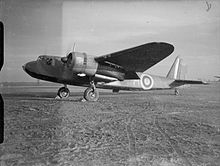No. 1 (Coastal) Operational Training Unit RAF
 From Wikipedia - Reading time: 8 min
From Wikipedia - Reading time: 8 min
| No. 1 (Coastal) Operational Training Unit | |
|---|---|
 | |
| Active | 1 April 1940 – 19 October 1943 |
| Disbanded | 19 October 1943 |
| Country | |
| Branch | |
| Type | Operational Training Unit |
| Role | Aircrew Training |
| Part of | RAF Coastal Command *No. 17 Group RAF |
No. 1 (Coastal) Operational Training Unit RAF (1 (C)OTU), was a training unit of the Royal Air Force, within No. 17 Group RAF, which was part of RAF Coastal Command. The unit was established during April 1940 by the redesignating of an existing RAF Coastal Command unit,[1] and disbanded during October 1943.[2][3]
History
[edit]
Coastal Command Landplane Pilots School
[edit]The Coastal Command Landplane Pilots School RAF formed at RAF Silloth on 1 November 1939. The school was equipped with Avro Anson I, a British twin-engine, multi-role aircraft, Lockheed Hudson I, a US light bomber and coastal reconnaissance aircraft, Bristol Beaufort I, a British twin-engined torpedo bomber, and Vickers Wellington I, a British twin-engined, long-range medium bomber aircraft. It was operational for around five months, before disbanding, at RAF Silloth, to reform as No. 1 (Coastal) Operational Training Unit.[4]
No. 1 (Coastal) Operational Training Unit
[edit]Forming on 1 April 1940, at RAF Silloth, by redesignating the Coastal Command Landplane Pilots School,[5] No. 1 (Coastal) Operational Training Unit initially trained aircrews for RAF Coastal Command landplanes and was equipped with Avro Anson, Lockheed Hudson, Bristol Blenheim, a British light bomber, and Bristol Beaufort aircraft. However, with the creation of more OTU's the unit started to specialise in training Lockheed Hudson aircrew.[1][5]

On 23 March 1943 No. 1 (Coastal) Operational Training Unit moved to RAF Thornaby and the unit also provided aircrew training for Consolidated Liberator, an American heavy bomber, Boeing Fortress an American four-engined heavy bomber, and Handley Page Halifax a British four-engined heavy bomber.[1] Roughly six months later, the Lockheed Hudson training moved to No. 5 (Coastal) Operational Training Unit RAF, before No. 1 (C) OTU disbanded on 19 October 1943,[2][5] and the heavy bomber courses for Handley Page Halifax and Boeing Fortress were taken over by No. 1674 Heavy Conversion Unit RAF at RAF Aldergrove,[6] which had not long formed, on 10 October 1943.[7]
Aircraft operated
[edit]
No. 1 (Coastal) Operational Training Unit was equipped with numerous types and variants of aircraft:[5]
- Avro Tutor
- Avro Anson I
- Blackburn Shark II
- Fairey Swordfish I
- Blackburn Roc I
- Bristol Beaufort I
- Fairey Battle
- Blackburn Botha I
- Vickers Wellington I, IA, IC and VIII
- Armstrong Whitworth Whitley V
- Lockheed Hudson I, II, V and VI
- Bristol Blenheim I and IV
- Westland Lysander III and IIIA
- Airspeed Oxford I
- Supermarine Spitfire I
- Handley Page Halifax II
- Miles Magister
- Boeing Fortress I and IIA
- Consolidated Liberator III and V
- Miles Martinet I
Airfields used
[edit]- RAF Silloth as Coastal Command Landplane Pilots School RAF from November 1939 and No. 1 (C) OTU from April 1940.[1]
- RAF Thornaby from March 1943 until October 1943.[2]
Accidents
[edit]During September 1942 a Lockheed Hudson I N7325 of the unit crashed on Cross Fell in the Peak District.[8]
See also
[edit]- List of Royal Air Force Operational Training Units
- List of Royal Air Force schools
- List of conversion units of the Royal Air Force
References
[edit]Citations
[edit]- ^ a b c "RAF Thornaby". Control Towers. Retrieved 30 April 2012.
- ^ Sturtivant 2007, p. 198.
- ^ Lake 1999, p. 50.
- ^ a b c d Lake 1999, p. 144.
- ^ Ashworth 1992, p. 187.
- ^ Lake 1999, p. 56.
- ^ "Lockheed Hudson Mk.I N7325 / B-59 of No.1 (Coastal) Operational Training Unit". Peak District Air Accident Research. Retrieved 30 April 2012.
Bibliography
[edit]- Ashworth, Chris (1992). RAF Coastal Command 1936-1969. Sparkford, UK: Patrick Stephens. ISBN 1-85260-345-3.
- Sturtivant, Ray RAF Flying Training and Support Units since 1912. Air Britain, 2007. ISBN 0-85130-365-X.
- Lake, Alan Flying Units of the RAF. Airlife Publishing Ltd., Shrewsbury, 1999. ISBN 1-84037-086-6.
 KSF
KSF